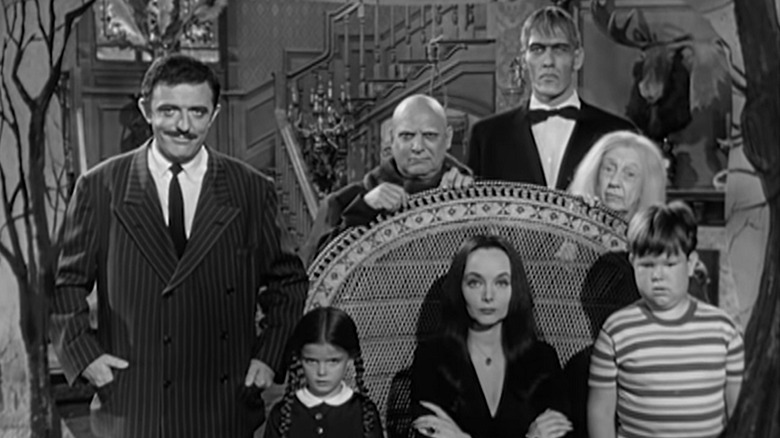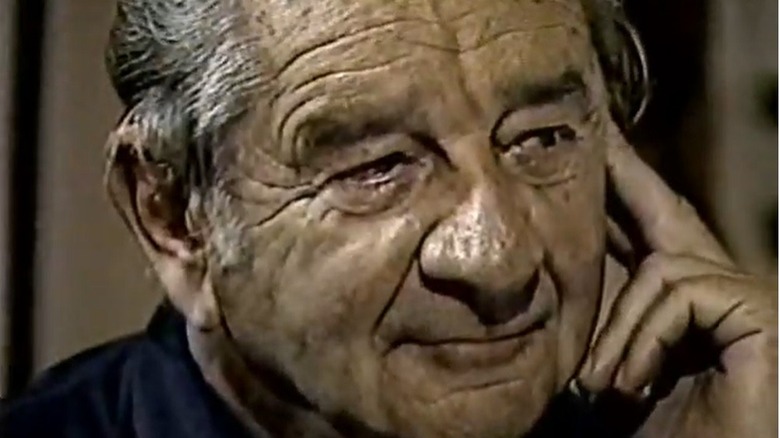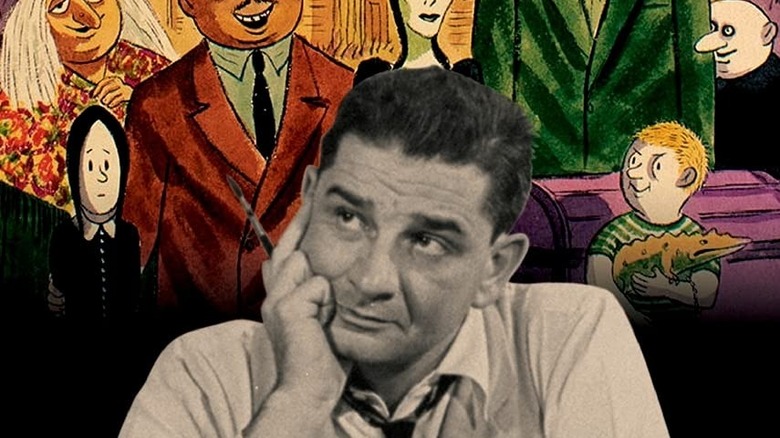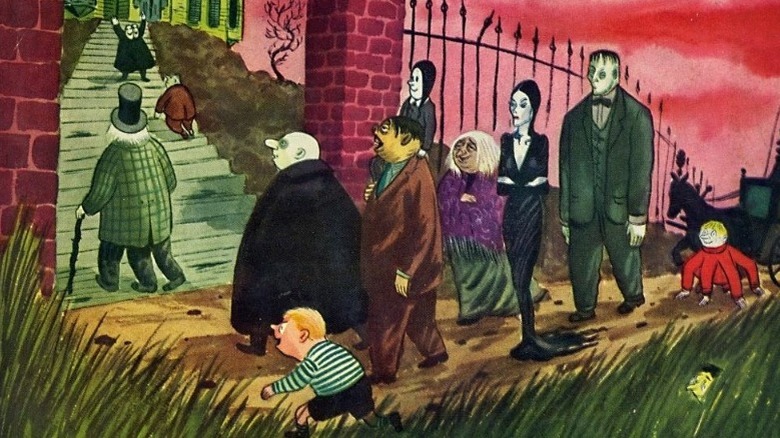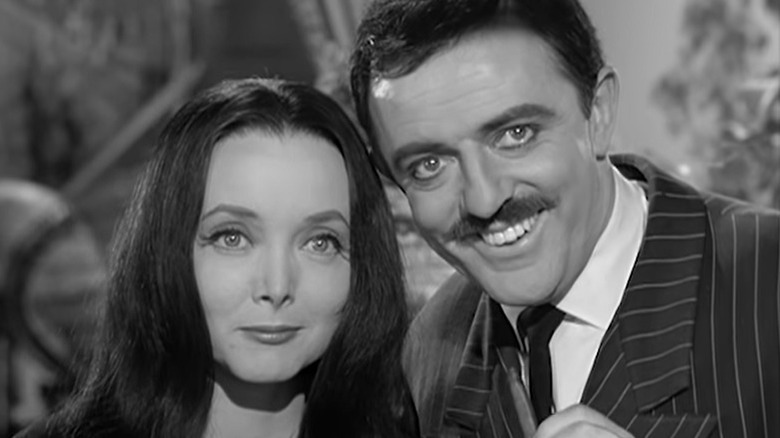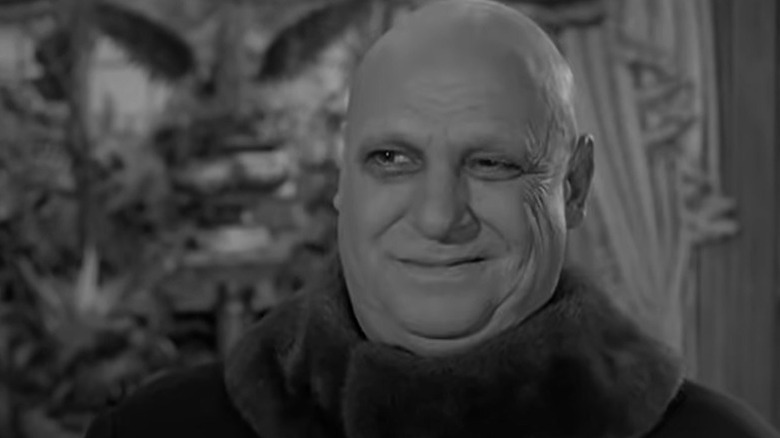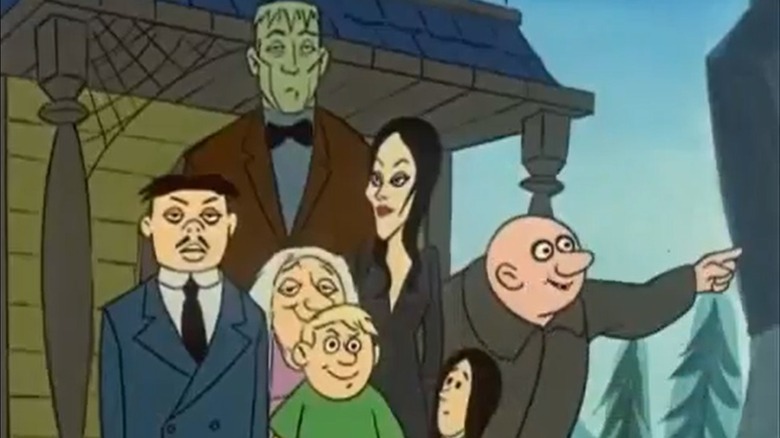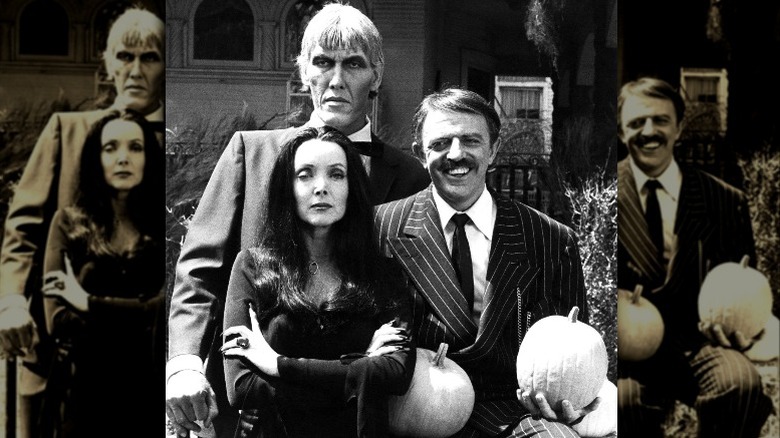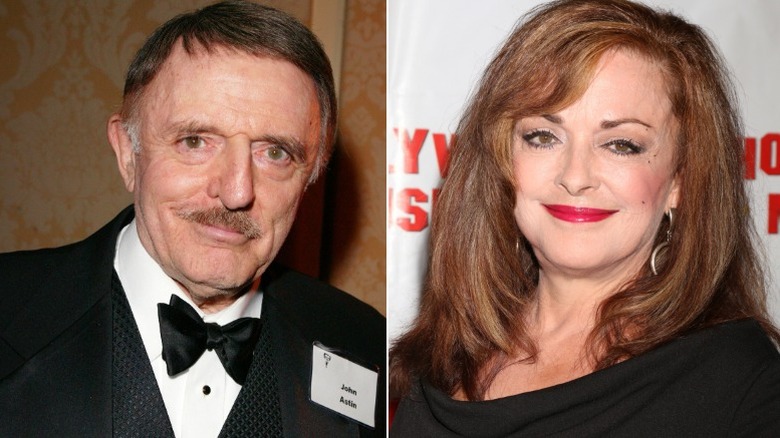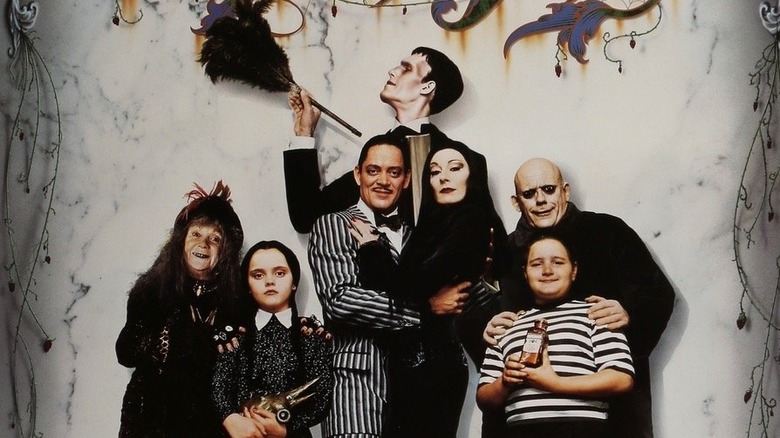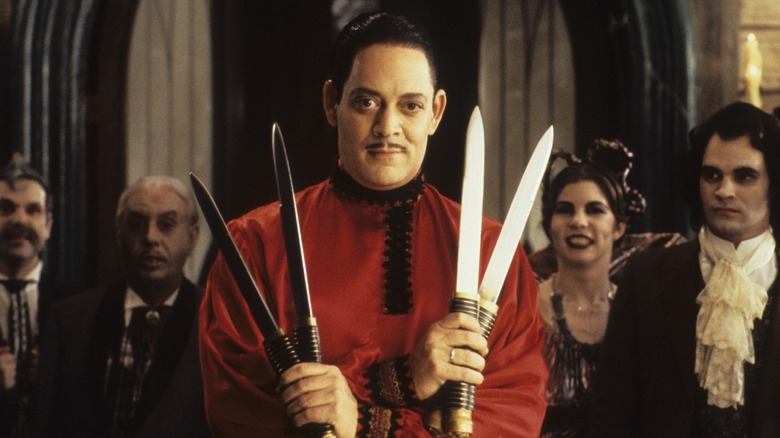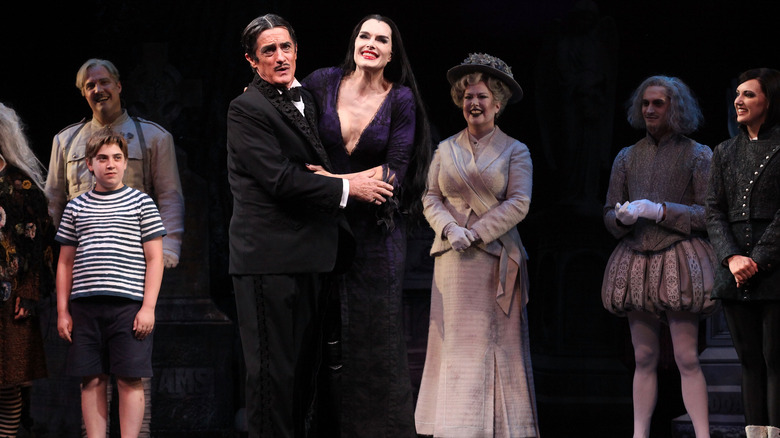Things Fans Might Not Know About The Addams Family
For over 80 years, the Addams Family have delighted readers and audiences with their wholesomely macabre humor across media ranging from print to TV and film to the Broadway stage. The brainchild of cartoonist Charles Addams, the originally unnamed characters who would become the Addamses first appeared in the pages of the New Yorker in 1938. A macabre send-up of American life, Addams' single-panel, black-and-white cartoons featured a weirdly morbid but tight-knit family living out a skewed idea of domestic bliss.
In 1964, Addams' cartoons would come to life on the small screen with the premiere of ABC's "The Addams Family." For the first time, Addams' characters had names: Gomez, the suave and eccentric head of the family; the svelte, mysterious Morticia; the bald, wacky, and electrified Uncle Fester; Lurch, the family's hulking butler; Thing, the ever-helpful disembodied hand; and the Addams children, Wednesday and Pugsley. Although the show ran for just two seasons and a total of 64 episodes, the Addams Family's story was far from over. A smash 1991 film adaptation followed by an equally well-received sequel brought the Addams Family back to the forefront of pop culture, where they have remained in a variety of incarnations ever since.
Of course, as the Addamses would be first to admit, all great families are bound to have some skeletons in their closets. These are the creepy, kooky, mysterious, and spooky facts about America's favorite freaky family.
Charles Addams could have been one of his cartoons
Born in Westfield, New Jersey, in 1912, Charles Addams had a childhood worthy of his namesake creation. As detailed in the biography "Chas Addams: A Cartoonist's Life," he claimed his earliest memory was seeing a man get run over by a car. Nicknamed "Chilly" by his friends, an 8-year-old Charles Addams and some neighborhood kids once broke into a crumbling Victorian house that was under renovation. In a bit of morbid vandalism, Addams drew skeletons all over the walls. Later, Addams and his chums were dragged into court to answer for their crimes. "It wasn't really an arrest, but I like to think of it as one," Addams would say years later. The cartoonist would base the Addams Family's home in part on the old house that got him in trouble.
According to friend Walker McKinney, Addams had an interest in "the aberrations of life" that manifested in his off-kilter sense of humor. When a consignment of soft-shelled crabs was delivered alive for a birthday dinner, Addams cheerfully suggested "Well, we'll stab them." However, when the hostess arrived at the more humane alternative of gassing the crustaceans in the oven, the artist reportedly deadpanned, "What a pity."
As Addams became famous for his work in the New Yorker, his reputation as an eccentric grew. He enjoyed picnicking in cemeteries and visiting snake farms, and reveled in telling reporters about the gifts he received from fans such as a gilded skull, a human thigh bone, and a frozen beef heart in a box.
Charles Addams lost his creative rights to his ex-wife
By 1942, Charles Addams had earned a reputation as a skilled artist with a wicked wit thanks to his New Yorker cartoons. Yet, his life was about to change forever. Addams was drafted to serve in World War II, and around the same time, he fell in love with a young woman who had more than a passing resemblance to one of his creations.
As detailed by biographer Linda H. Davis, Barbara Jean Day was a slender, pale-skinned beauty with black hair. A dead-ringer for Addams' witch-woman character, who would later become Morticia, Day was known for her sweet nature and willingness to "do anything on a dare." She and Addams married in 1943, but their union ended eight years later, when Addams refused to adopt a child. Heartbroken, Day left Addams for another man.
Addams' second wife, Barbara Barb, also had a striking resemblance to Morticia. A practicing lawyer with a fiery temper, Barb was prone to fits of rage during which she would destroy Addams' possessions and clothing. On occasion, she would become physically abusive, burning the cartoonist with lit cigarettes and striking him over the head with a stiletto heel. Although their marriage lasted only two years, the consequences haunted Addams for the rest of his life. Barb convinced Addams to sign away the rights to much of his work and, as documented by the New York Times, wound up in control of the Addams Family TV and movie franchises.
The Addams Family's disappearance from print
As reported by the Los Angeles Times, in 1963, television producer David Levy was on 5th Avenue in New York with a friend when he spotted a display of Charles Addams' books in a store window. Taken with the cover of "Homebodies," which featured a portrait of the entire Addams clan on the cover, Levy exclaimed, "There's a hit series!"
Levy tracked Addams down and pitched the artist his idea for a situation comedy based on the far-out family featured in his cartoons. Addams fleshed out the characters with personalities and names, and Levy went about casting the series. After some legal wrangling with Addams' ex-wife, Barbara Barb, "The Addams Family" finally premiered on September 18, 1964.
A ratings hit, "The Addams Family," touched a nerve with '60s viewers and opened up a new audience to the world of Charles Addams. Although Addams enjoyed the show, he was somewhat disappointed in that TV had blunted his characters' sharper edges stating that the Addams Family had been transformed into "almost a typical suburban family. Not half as evil as my original characters."
New Yorker editor William Shawn was much less impressed with the Addams Family's leap to the small screen. Not wanting the prestigious publication to be associated with TV characters, Shawn banned the Addams Family cartoons from the New Yorker. The Addams brood finally returned to the magazine's pages in 1987, upon Shawn's retirement.
The Addams Family versus The Munsters
On September 24, 1964, just six days after "The Addams Family's" ABC premiere, another creepy family moved into primetime TV on rival network NBC. "The Munsters," produced by TV power duo Bob Mosher and Joe Connolly, domesticated Universal's classic movie monsters and brought them into a family sitcom setting.
While the Addamses reveled in their weirdness, the Munsters were more or less portrayed as a typical American TV family in the mode of "Leave it to Beaver" or "Father Knows Best." That the Munsters were literal monsters was incidental to the show's generally broad, slapstick comedy. "The Addams Family," however, tended to take a more sophisticated approach in its humor, peppering the laughs with sly sexual innuendo and a generally darker tone. Although both "The Addams Family" and "The Munsters" ended in 1966, dedicated fans continue to debate which was the better show.
Two shows featuring macabre families premiering at virtually the same time was no coincidence. As documented by horror historian David J. Skal in "The Monster Show," both "The Addams Family" and "The Munsters" were part of a wave of renewed interest in horror that began in the late 1950s with the release of Universal Studios' classic horror films on TV. The monster boom that would culminate with "The Addams Family" and "The Munsters" would also usher in such cultural touchstones as "Famous Monsters of Filmland Magazine," Aurora movie monster models, and Bobby "Boris" Pickett's hit song "The Monster Mash."
The tragedies and triumphs of Jackie Coogan
Arguably, the most way-out member of the Addams family is the lovably bizarre Uncle Fester. A fixture of Charles Addams' cartoons, Fester was memorably brought to life by actor Jackie Coogan.
Born in Los Angeles in 1914, Coogan was one of the most famous child stars in Hollywood history. As chronicled in "Hollywood Kids," by Thomas G. Aylesworth, the legendary Charlie Chaplin launched Coogan into international fame when he cast the young actor in the 1921 comedy "The Kid." By 1923, Coogan was the No. 1 box office draw in America, ahead of both Rudolph Valentino and Douglas Fairbanks.
In 1935, 20-year-old Jackie Coogan was the sole survivor of a devastating car crash that killed his father, best friend — the actor Junior Durkin — and another man. Shortly after the accident, tragedy befell Coogan again when he contacted his mother to secure the $4 million he had earned in film. To his dismay, he learned that his parents had squandered most of his money. Consequently, Coogan filed suit against his parents and eventually won a settlement for $126,000. Coogan's plight resulted in the California legislature instituting the Coogan Law to protect the assets of child actors.
Just before World War II, Coogan enlisted as a medic. After transferring to the Army Air Corp, Coogan, already an experienced pilot in civilian life, flew gliders behind enemy lines with a crack commando unit. Following the war, Coogan returned to acting but never again achieved the notoriety he enjoyed in his youth.
The Animated Addamses
With the cancelation of "The Addams Family" in 1966, the all together ookie adventures of TV's spookiest family seemed to be over for good. Yet, the Addamses would return in animated form thanks to everyone's favorite Saturday morning mystery-solving gang.
"The New Scooby-Doo Movies" premiered in 1972 as a followup to 1969's wildly successful "Scooby-Doo, Where Are You?" In addition to their usual hijinks, Scoob, Shaggy, Velma, Daphne, and Fred took on mysteries that brought them together with a variety of celebrities and guest stars ranging from Sonny and Cher to Batman. In the series' third episode, Mystery Inc. helps Morticia and Gomez locate a kidnapped Wednesday. Original cast members John Astin, Carolyn Jones, Jackie Coogan, and Ted Cassidy returned to voice their roles. This animated incarnation of the Addamses returned in 1973 (minus Astin and Jones) with their own Saturday morning cartoon. Simply titled, "The Addams Family," the show ran for 16 episodes and featured the family traversing America in a mobile replica of their spooky mansion.
As documented in Jeff Lenburg's "Encyclopedia of Animated Cartoons," the hit 1991 big screen adaptation of "The Addams Family" spawned yet another animated show in 1992. This version found the Addamses coping with their "weird" neighbors in idyllic Happydale Heights, and featured original cast member John Astin as the voice of Gomez."
In 2019, the family returned with an all new CG animated film from directors Greg Tierenan and Conrad Vernon, with Oscar Issac and Charlize Theron as Gomez and Morticia.
A pair of unlikely Pugsleys
The late Ken Weatherwax, from the '60s TV show, and Jimmy Workman, who appeared in 1991's "The Addams Family" and '93's "Addams Family Values," are arguably the franchise's definitive Pugsleys. However, they are far from the only actors to have played the role of Gomez and Morticia's stripe-shirted son. Actor Jerry Messing appeared as Pugsley in the 1998 direct-to-video movie "Addams Family Reunion." Brody Smith would take the role for the short-lived reboot series airing from 1998 to 2001, and "Stranger Things'" Finn Wolfhard voiced Pugsley in the 2019 animated feature.
However, in one of the most ironic examples of casting in TV history, none other than Butch Patrick, best known as Eddie Munster in rival sitcom "The Munsters," played a teenage Pugsley in the single aired episode of the 1973 variety show "The Addams Family Funhouse." According to MemorableTV.com, no principal members of "The Addams Family" cast reprised their roles in the syndicated show save for Felix Silla as Cousin Itt.
Although film fans know Jodie Foster as an Oscar-winning actor and director, the star of "Silence of the Lambs" was a popular child star throughout the late '60s and early 1970s, appearing in TV classics as "The Courtship of Eddie's Father" and "The Partridge Family." In 1973, she officially became an Addams when she voiced Pugsley in "The Addams Family" animated series.
A Halloween last hurrah
In 1977, most of the original "The Addams Family" cast reunited for the NBC Halloween special "Halloween with the New Addams Family." John Astin, Carolyn Jones, Jackie Coogan, Ted Cassidy, Ken Weatherwax, and Lisa Loring all reprised their roles from the 1964 series. Jane Rose, best known for her role as Cloris Leachman's mother-in-law on the "Mary Tyler Moore Show" spinoff, would fill in for an ailing Blossom Rock as Grandmama.
The plot of the film centers on a group of crooks out to steal the Addams' fortune during the family's annual masked Halloween celebration. To complicate matters, Gomez's brother Pancho, played by Henry Darrow, has returned and may have romantic intentions towards Morticia. Gomez, with the help of Fester and Lurch, foils the dastardly plot, and the brothers patch up their frayed relationship just in time for the family to sing Halloween carols.
As documented by the entertainment website Decades, "Halloween with the New Addams Family" is definitely a product of its time. Shot on video tape, the film lacks the gloomy, gothic atmosphere of the '60s TV show, and the nostalgia of seeing the original cats back together is its main charm.
Addams Family Survivors
Two of the original members of "The Addams Family" cast died shortly after the 1977 Halloween special. Blossom Rock, who had suffered a debilitating stroke shortly after "The Addams Family" ended, died on January 14, 1978 at the age of 82. Ted Cassidy died the following year, at age 46, from complications following surgery to remove a tumor from his heart.
On August 3, 1983, Carolyn Jones, just 50 years old, died of colon cancer. Jackie Coogan died of a heart attack in March, 1984. A heart attack would also kill 59-year-old Ken Weatherwax in 2014.
With the 2019 death of veteran actor Felix Silla – the man under Cousin Itt's bowler hat — John Astin and Lisa Loring are the last surviving members of the original "The Addams Family" cast.
Baltimore-born Astin, now in his 90s, remains active with occasional TV and voiceover work. Astin also toured the country for a number of years in the popular one-man show "Edgar Alan Poe: Once Upon a Midnight." Currently, Astin teaches acting at Johns Hopkins University, where he serves as Theatre Program Director and Homewood Professor of the Arts.
As detailed by People, Loring, who played little Wednesday Addams, went on to originate the role of Cricket Montgomery on the soap "As the World Turns." Following a failed marriage to adult film star Paul Seiderman, Loring descended into drug abuse. She beat addiction in the 1990s, and is now a popular guest at fan conventions and autograph shows.
Making the 1991 film was a nightmare
The 1991 film "The Addams Family" was a huge box office success that brought Charles Addams' cartoons to life for a new generation. Yet, the production proved nearly as tortuous as a night in Fester's dungeon. As detailed in director Barry Sonnenfeld's book, "Call Your Mother: Memoirs of a Neurotic Filmmaker," producer Scott Rudin turned to Sonnenfeld as a last resort to get the film made after Tim Burton and Terry Gilliam passed on the project. Sonnenfeld was the right fit for the job, but he had to surmount a terrible script. With the help of writer Paul Rudnick, Sonnenfeld made countless revisions, which continued into filming.
As detailed in a 1991 "Entertainment Weekly" article, the film faced another potential setback when debt-riddled Orion Pictures sold the project off to Paramount. Last minute budget cuts threatened to stop the production.
Sonnenfeld, subsisting on a diet of cappuccino and little sleep, collapsed under the stress of production. Yet, he wasn't the only one to feel the strain. In her 2014 biography "Watch Me: A Memoir," Morticia actress Anjelica Huston recalls her time on the set as "long and arduous." Laced into an impossibly tight corset, Huston found that she couldn't sit down and had to be transported prone in the back of a station wagon from location to location.
Raul Julia, the heart and soul of the Addams Family
Before being cast as Gomez in 1991's "The Addams Family," Raul Julia was best known for his dramatic roles in films including "Kiss of the Spider Woman." A serious actor, Julia also had impeccable comedic chops. With a performance that rivals John Astin's, Julia brought a passion and intelligence to the role that remain unequalled.
In her 2014 autobiography "Watch Me: A Memoir." co-star Anjelica Huston writes, "Raul Julia was the heart and soul of 'The Addams Family,' he held us together with his sweet nature... He was kind to everyone... "
Julia, joyful as ever, returned for the 1993 sequel, "Addams Family Values." Huston noticed that the noticeably thinner Julia was having difficulty eating. Diagnosed with stomach cancer two years before, he kept his condition secret. After suffering a stroke that left him in a coma for eight days, Raul Julia died on October 24, 1994. He was 54.
Addams Family forever
In the 80-plus years since the first Addams Family cartoon appeared in the New Yorker, Charles Addams' macabre creation has become an iconic piece of the American pop culture landscape. Despite trailing "The Munsters” in the ratings during its '60s TV incarnation, the Addams Family has built a legacy that has outshined the rival franchise. To date, the Addams Family has spawned four feature films, a Halloween special, a 1998 revival series that outlasted the original by one episode, two animated series, a hit Broadway musical, and a wildly popular pinball machine.
The creepiest, kookiest family of all time continues to thrive into the 21st century. After passing on the opportunity to direct the 1991 film, Tim Burton is finally getting his shot at the long running franchise. As reported by Deadline, the "Beetlejuice" director is helming an Addams Family spin-off titled "Wednesday," which is set to launch on Netflix in 2022.
